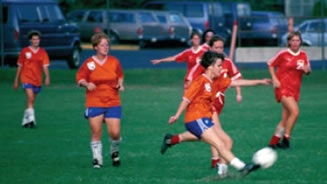The courts grow impatient with administrators still confused about the scheduling of seasons.

After 32 years, however, educational and athletic administrators still seem to be trying to figure out what constitutes discrimination under Title IX. A recent example of the continuing difficulty is McCormick v. School District of Mamaroneck and School District of Pelham [370 F.3d 275 (2004)]. In McCormick, the parents of two female soccer players, Katherine McCormick and Emily Geldwert, sued two New York school districts over their decision to play girls' soccer in the spring, instead of the traditional fall season. In particular, the parents argued that since the boys' teams in both school districts play in the fall and are able to compete for regional or state championships, the school districts are violating the "equal treatment" requirement of Title IX. Girls' soccer is the only sport in the two districts that is scheduled in a season that precludes post-season play.
The parents presented two additional arguments in support of their discrimination claim. First, they argued that by scheduling girls' soccer in the nontraditional spring season, girls were at a disadvantage when it came to college scholarship opportunities. Second, they argued that the districts were forcing girls to decide between playing on their high school teams and playing on club or Olympic Development Program ("ODP") teams, two other spring programs. As a result, the parents argued, girls who play high school soccer in the spring, unlike boys who play in the fall, are overscheduled, experience participation conflicts and face a greater risk of injury.
In support of the decision to schedule girls' soccer in the spring, the districts pointed to the popularity of girls' field hockey in the region. If the schools played soccer in the fall, the districts argued, girls would be forced to choose between field hockey and soccer. Therefore, the districts argued, moving soccer to the fall would actually limit the opportunities for girls at the schools, not increase them. In addition, the districts argued that because of all the other field sports taking place in the fall (especially football), the districts had limited space on which to hold practices and games. Finally, since each district employs one coach to serve both the girls' and boys' soccer teams, the current coaches would be required to give up coaching one of the teams. The districts argued that this would be discriminatory to one of the teams; since there were not enough qualified coaches in the area, one team would get inferior coaching.
Disappointed with the district court's decision that the school districts were in violation of Title IX, the districts appealed to the Second Circuit Court of Appeals. After acknowledging that Title IX does not require identical scheduling for boys and girls, the Second Circuit held that compliance under the "equal treatment" component of Title IX needs to be assessed under a two-part test. Under the first test, the court would have to determine whether the difference in scheduling had a negative impact on one sex. If so, the second test would require the court to determine whether the disparity is substantial enough to deny members of that sex equality of athletic opportunity.
In reviewing the case, the Second Circuit held that scheduling girls' soccer in the spring clearly has a negative impact on girls, since boys could compete in regional and state soccer championships, and girls could not. Yet, the court ruled that the school districts could offset this negative treatment if they could point to another area in which female athletes received comparably better treatment than male athletes at their schools. Since the districts were unable to offer any evidence that the disparity suffered by the girls' soccer players was offset by some comparable advantage to girls or disadvantage to boys in another area of the Mamaroneck and Pelham athletic programs, the court would have to determine whether the disparity was substantial enough by itself to deny girls at the Mamaroneck and Pelham schools equality of athletic opportunity.
In claiming that the disparity was not substantial enough to violate Title IX, the school districts argued that it was unlikely that the girls' teams would even qualify for championship games. In support of this argument, the districts pointed to the fact that the Pelham and Mamaroneck teams did not even win their sectional championship. Not persuaded by this argument, the court ruled that the primary purpose of competitive athletics was to strive to be the best. By scheduling soccer in the spring, the court held, the districts placed a ceiling on the possible achievement of female soccer players that they could not break through no matter how well they played. Treating girls differently in a matter so fundamental to the experience of sports, the court concluded, was inconsistent with Title IX's mandate of equal opportunity for both sexes.
As to the districts' arguments involving the availability of field space, officials and qualified coaches, the Second Circuit held that these were not the kind of nondiscriminatory factors that can justify inferior treatment of female athletes. For example, while hiring a new coach and finding more game officials may cost money, the fact that money needs to be spent to comply with Title IX is obviously not a defense to the statute. Also, the court ruled, since the districts were unable to demonstrate that finding field space for practices would be impossible or result in significantly shorter or more infrequent practices, the districts would have to make some adjustments to provide field space to the girls' soccer teams for practices and games.
Having found that none of the reasons offered by the districts justified offering unequal competitive opportunities to girls and boys, the Second Circuit upheld the district court's ruling and found the school districts in violation of Title IX. The Second Circuit Court went on to say that its decision was not intended to foreclose the possibility that scheduling a sport in a nontraditional season could, under certain circumstances, be permissible under Title IX.
For example, a school that denied comparable championship opportunities to boys and girls in equal numbers would not be in violation of Title IX.
The Second Circuit, however, rejected the district court's insistence that each school district develop a plan pursuant to which it shall offer soccer to boys and girls in the same season. Instead, the court ruled that the districts could be in compliance with Title IX if they offered soccer to girls and boys on a rational alternating basis, as long as girls, who have been thus far denied the fall season, were scheduled in the upcoming fall 2004 season. The relevant inquiry, the court held, was whether girls and boys are given equal opportunities for post-season competition, not whether the sports are scheduled in the same season.
Finally, since the court held that the districts could avoid the administrative problems they complained about by alternating boys' and girls' soccer in the fall season, the court refused to decide on the availability of an "administrative hardship defense," if any, or the threshold that would suffice to justify a significant disparity in equal athletic opportunity on the basis of such a defense.
While the court's decision will have an immediate impact on the Mamaroneck and Pelham school districts, which now must either move girls' soccer to the fall or alternate playing girls' and boys' soccer in the fall, the decision will also likely force other public schools in New York to move girls' soccer to the fall or risk litigation.
As for schools outside of New York, the Second Circuit's decision should send a very clear message, particularly when combined with the decision of the Sixth Circuit Court in Communities for Equity v. Michigan High School Athletic Association [2004 U.S. App. LEXIS 15437; 2004 FED App. 0241P (6th Cir.)]. In that class-action lawsuit, decided on July 27, the appeals court ruled that MHSAA's scheduling of girls' sports in nontraditional seasons discriminated against female athletes on the basis of gender.
With the number of girls playing junior high and high school sports increasing every year, the parents of these girls have taken a leading role in using Title IX to gain equal treatment for their daughters. The McCormick and Communities for Equity decisions, therefore, should place educational and athletic administrators on notice that both boys and girls have the same right to compete during traditional seasons and in post-season championships and tournaments.




































